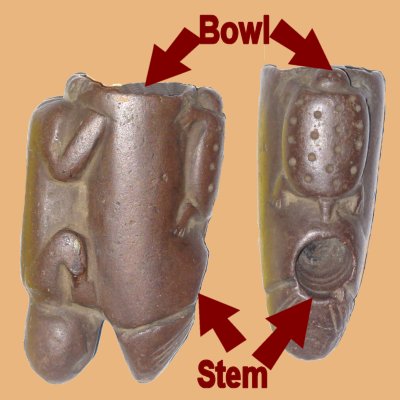Obsidian, Catlinite, and Copper
A Winnebago traveling merchant has arrived in Chogan’s village with obsidian and catlinite from the land with no trees. This may come as a surprise if you thought Indians had no contact with people from far-away places. You may also be wondering what was so special about obsidian and catlinite. Survival in early American was difficult even in the best of times. To make life easier, Indians used plants, animals, and stones to provide food and create their tools and clothing. Sometimes what they needed was not available locally. Obsidian and catlinite were two such items.
Obsidian

During the summer of 1935 the author's father-in-law (Robert Mickey) found the projectile point at the left in a freshly-plowed field on his grandfather’s Ohio farm. Judging from where Mr. Mickey discovered the projectile point and its turkey-tail stem, it is probably a two-thousand year old Adena/Hopewell Indian artifact. What makes this most interesting is the black obsidian used to create the projectile point. Obsidian is a form of volcanic glass not found east of the Rocky Mountains (more than a thousand miles away). Early Native Americans prized obsidian because it chips like glass and is easily crafted into sharp knives and projectile points. This particular piece of obsidian probably arrived in Ohio by canoe via the Missouri, Mississippi, and Ohio Rivers.
Catlinite

The artifact at the right (also courtesy of Robert Mickey) is a ceremonial pipe bowl carved from catlinite. Catlinite is the second softest stone and can be carved with a knife. The largest source of catlinite is in Southwestern Minnesota, which is another long trek from Ohio. An ancient Native American carved a turtle on one side of the pipe bowl and a human figure on the opposite side. This is probably another two thousand year old Adena/Hopewell artifact.
Copper
Chogan would not have to travel far to find native copper like the specimen at the left. Nuggets of pure copper were abundant throughout the Keweenaw Peninsula in Upper Michigan. The copper was first mined by unknown people 7,000 years ago. We don’t know who they were, but archeologists have found artifacts created from the Upper Peninsula copper throughout the Eastern United States. Native Americans never discovered how to anneal copper, which severely limited it use. When Europeans arrived Chogan’s people inhabited the Keweenaw Peninsula, but did not mine the copper.
The above stones may be interesting, but I think Chogan is more concerned with the Winnebago merchant’s news about war with the Sioux Nation. Chogan has his own bow and arrows. Will his people expect him to fight in the war? Let’s get back to the story and find out.
